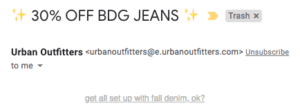
Ahhhh, emojis. Our fun little friends that live inside our devices to help us convey an emotion that, sometimes, gets lost in translation over text messages, tweets, and social media content.
You either love them or you hate them, but no matter your view on them, it’s undeniable that they are dominating today’s communication. (I mean, there’s an entire day dedicated to them.) Take a quick scroll through your timeline. I bet you can’t get through two posts without seeing an emoji used in the caption or comments.
Emojis are useful for brands looking to connect with an online audience. Latching on to this simplistic style helps users feel like they are talking to a human, rather than a brand.
A study from Socialbakers analyzed the top 500 brands and found that 59% of them included emojis in their tweets, while 40% also featured them in Facebook posts.
It’s reported that including an emoji in a tweet can increase engagement by 25.4% while using them in a Facebook post can increase Likes by 57% and comments and shares by 33%.
So, the question is: How should brands be using emojis? Do they use them everywhere—such as social media content, when responding to customers, their website? There’s a time and place for every emoji, but it all comes back to your brand voice.
Approaching emojis for your brand is different than how you use them personally. When establishing a tone and defining the persona behind your brand, use this opportunity to select emojis that compliment it—not take away or confuse.
If you’re an Instagram account selling clothing to teenage girls then it’s an obvious choice that you should be using all the emojis that resonate with them. Hearts, smileys, food, lipstick, heels. You know what to do.
Even if you’re running an account that is more serious, such as a doctor or lawyer, there are still ways for you to use emojis to promote your services. Try arrows, stars, or other symbols that can add character but keep the professionalism there.
Instagram captions were practically made for emojis. It’s a visual platform and an emoji can help stop the user from scrolling to the next photo by grabbing their attention. In the below example, Benefit Cosmetics uses siren emojis to help signify something important is happening.
The placement and emojis used help draw attention and is an effective way to stand out in the feed from other social media content. It’s not tacky, doesn’t interfere with their message, and is on par with their brand voice
A place to include emojis that is often overlooked but, in my opinion, necessary, is in bios. Your bio is your first impression; your first opportunity to show off your brand personality and can make people stay or stray.

Another place where emojis can really make a difference? Email subject lines. No, seriously. It really works. In fact, in a test by Experian, they discovered that including an emoji in your email subject line lead to a 56% higher open rate than a text-based subject line. Here is an example of a subject line that is currently in my inbox from Urban Outfitters.

Did it work? Yes, I actually clicked through and purchased their BDG jeans and the sparkles helped me feel magical all the way to check out.
All of this information tells us one thing: brands should be using emojis. When there is a new way to communicate and connect with your audience, take advantage! The key is to not go overboard and don’t use emojis that aren’t aligned with your brand voice.